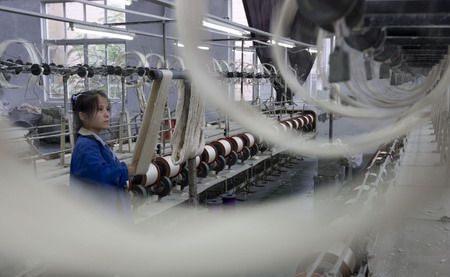Economy
Large industrial firms' profits up
Updated: 2011-03-29 09:53
By Chen Jia (China Daily)
A laborer on the assembly line of a cotton yarn company in Shaoxing, Zhejiang province. The profits of large companies rose 34 percent year-on-year to 645.5 billion yuan in the January-February period, but the growth rate was 15 percentage points lower than that in the first 11 months of 2010. [Photo / China Daily]

The Jan-Feb growth rate of 34 percent was significantly lower than that in the year-ago period
BEIJING - The profit growth of China's large industrial companies registered a year-on-year 34 percent increase in the first two months of this year, according to data released by the National Bureau of Statistics (NBS) on Sunday.
The rate was significantly lower than the 119.7 percent year-on-year growth achieved in the first two months of 2010, the highest in two years, the NBS said.
The companies' profits were 645.5 billion yuan ($98 billion) in the January-February period, but the year-on-year growth rate was 15 percentage points lower than the 49 percent achieved in the first 11 months of 2010.
A rapid rise in production costs and more monetary tightening measures may continue to hurt business earnings, analysts said.
Soaring commodity prices in global markets drove up manufacturers' costs for raw materials, fuel and energy, and have become one of the most important factors in shrinking profit margins, said a report jointly released by the Ministry of Industry and Information Technology and the Institute of Industrial Economics at the Chinese Academy of Social Sciences.
China's Producer Price Index (PPI), the gauge of factory-gate prices, jumped 7.2 percent last month from a year earlier, pushed by rising raw material prices. The country's inflation index exceeded expectations in February, rising to 4.9 percent year-on-year.
Industrial manufacturers are under increasing pressure from rising labor costs resulting from higher consumer inflation, said Huang Yiping, a professor at the National School of Development at Peking University. "Wages will rise faster in the next five years," he said.
"It is the time for companies to innovate technologically, take advantage of financial instruments and pay more attention to intellectual property protection, which are the keys to earn sustainable profits," said Huang.
Huang is also worried that tight monetary policies may slow the world's second-largest economy without any transitional period, "and that will be very harmful for domestic enterprises".
| ||||
The central bank also raised interest rates in February for the third time since October to curb bank lending.
Lu Zhengwei, a senior economist at Industrial Bank Co Ltd, said China's Consumer Price Index (CPI), a key gauge of inflation, is predicted to rise as high as 5.2 percent in March, compared with 4.9 percent in February. There may be another rise in the banks' reserve requirement ratio in the first half of April, and one more hike in interest rates in the second half, said Lu.
According to the statistic bureau, 38 out of the 39 industries surveyed reported profit growth during the two-month period, while the chemical material and products industries had the highest profit growth rate.
The NBS also said that it has updated the definition for the country's so-called "above-scale enterprises" since the beginning of this year. This now refers to those with an annual sales volume of more than 20 million yuan, up from 5 million yuan previously.
According to a March 8 statement from the NBS, based on 2009 figures, the number of companies involved will decrease by 40.6 percent after the change.
E-paper

Rise and shine
The Chinese solar energy industry is heating up following recent setbacks in the nuclear sector
Bombs aim for regime change
CSI, with a twist
Literary path
Specials

Peony express
Growers of china's unofficial national flower are reaching out to europe for help

Tea-ing up
More turning to Chinese tea for investment opportunities like vintage wine

A cut above
The ancient city of Luoyang is home to a treasure trove of cultural wonders.




